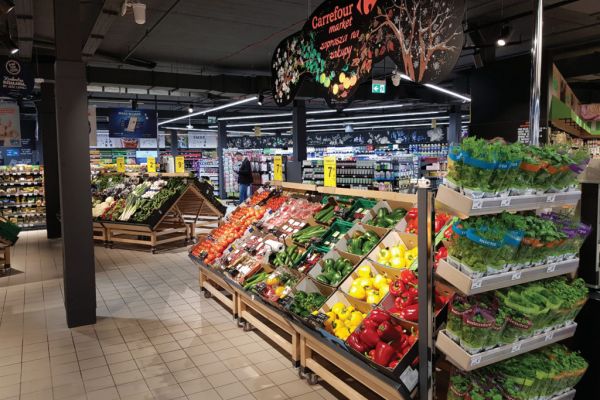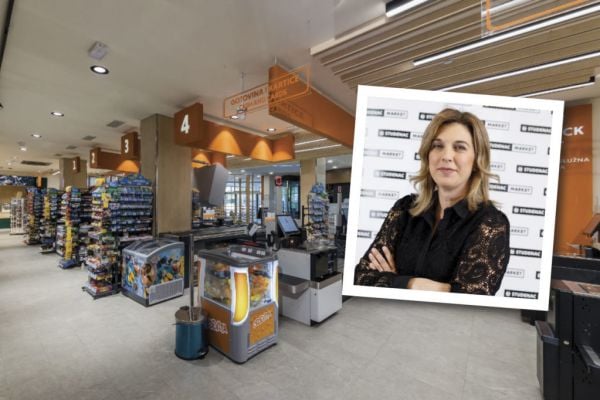Having navigated successfully through the COVID-19 pandemic, the fruit-and-vegetable industry will be looking to accelerate growth next year. This article first appeared in ESM Issue 6 2020.
To say that it has been a year of contrasts for the European fruit-and-vegetable sector is an understatement. On the one hand, the industry has had to navigate the COVID-19 pandemic and the concurrent changes to consumption behaviours. On the other, the recently announced European Green Deal, with the Farm to Fork Strategy at its heart, hints at a promising future, albeit perhaps a somewhat aspirational one.
Farm To Fork
The Farm to Fork Strategy – which was finally announced in May, after a couple of false starts – has the potential to have a transformative effect on the fresh-produce supply chain, bringing health and sustainability to the forefront of the food production process.
It has set a target of 25% of agricultural land across the EU to be farmed organically by the end of the decade, a 50% reduction in the use of chemical pesticides and a 20% reduction in fertiliser use within the same period, and the introduction of incentivisation measures, to enable producers to achieve these goals.
Announcing the strategy, Commission executive vice-president Frans Timmermans said that the Farm to Fork Strategy, alongside the Biodiversity Strategy, is a “central element of the EU’s recovery plan. They are crucial for our health, for our well-being, and are crucial for creating immediate business and investment opportunities so that we can restore the EU’s economy as fast as possible. [...] They are about telling people how they can make their choices better informed, so we give them what they deserve: more sustainable food, better information, and to bolster their rights to choose.”
Commenting on the initiative, Freshfel Europe, which represents the interests of the fresh fruit-and-vegetable supply chain in Europe, stated that it supported the ‘ambitious nature’ of the initiatives outlined in the strategy, but that it had reservations over the viability of some of these measures.
“The Farm to Fork Strategy must have a holistic view and take overall production environmental performance into account, which should not be disregarded in preference for organic,” commented Freshfel Europe general delegate Philippe Binard.
“The fresh fruit-and-vegetable sector’s ability to provide high-quality, safe, nutritious and affordable food to consumers and adequate return for growers should not be compromised. Effective alternative tools must be provided for growers to cope with invasive species and plant diseases if plant protection product use is to be reduced.”
Freshfel Europe also noted that while the strategy references the current insufficient consumption of fruit and vegetables within the EU, it falls short on outlining specific initiatives to directly support the European fresh fruit-and-vegetable sector.
Promoting Consumption
Building on this, in October, Freshfel Europe called on the European Commission to retain the €200 million promotional budget in its 2021 annual work programme (AWP) and double the fruit-and-vegetable sector’s allocation to €16 million, in order to promote increased consumption. Consumption in the European Union has stagnated at around 345g per capita, per day, which is less than the WHO-recommended amount of at least 400g per day.
By increasing the budget allocation for the promotion of fruit and vegetables, the sector would be in a better position to capitalise on the upcoming 2021 UN International Year of Fruits and Vegetables, Freshfel suggested, and reinforce promotional activities advocating healthy, sustainable diets.
The COVID Effect
As outlined in ESM’s previous Fresh Produce feature, in May of this year, the fruit-and-vegetable sector performed admirably in its response to COVID-19, with the introduction of ‘fresh corridors’, to facilitate regional transportation, and a quick response to panic-buying trends. This was, however, offset by a number of on-the-ground issues that the sector will be eager to overcome, such as foodservice closures and the unavailability of seasonal workers, to say nothing of the threat of a looming recession.
Rabobank recently undertook a study, The Next Normal: Fresh fruit outlook amid and post the COVID-19 pandemic, looking at the likely after-effects of the pandemic on the fresh-produce supply chain. It notes that while the global economy is showing signs of recovery, this is being marred by continued uncertainty and geopolitical tensions. More specifically, it examines the impact on the fresh-fruit sector over three stages: the current ‘COVID-19 Pandemic’ stage, the likely ‘Recession’ stage that will follow, and the ‘Post-COVID-19’ period.
In the first of these, the COVID-19 Pandemic stage, the initial panic-buying wave has led to more focus on local purchasing and online shopping, a focus on basic items, strong retail turnover, and a collapse in the foodservice market. The challenges for businesses arising out of this have been well documented, including price volatility, labour availability, logistical issues, and an increase in costs (by around 5% to 10%).
As this makes way for a likely Recession stage, market trends are likely to see retail sales remain higher than normal, with foodservice continuing to be subdued, leading to challenges such as fiercer competition, low air freight capacity, exchange rate impacts, and more additional costs.
If the recession is a particularly deep one, Rabobank notes, some of the trends evident in the global financial crisis of ten years ago may re-emerge, such as a ‘trading down’ by consumers and a levelling-off of fruit consumption. At the same time, though, this crisis has already proven itself to be different, with health consciousness increasing and consumers embracing new consumption channels.
The final stage, Post-COVID-19, is one in which firms operating in the sector will need to build resilience, with more supply chain cooperation, the need for new sourcing opportunities, and a rethink of labour and logistics structures. To some degree, all three of these scenarios have coexisted in the past year, as markets went in and out of lockdown, against the backdrop of widespread drops in GDP.
Tracking Trends
What effect does this have on the fruit and vegetable products that we are consuming? As Cindy van Rijswick, senior analyst for fruit, vegetables and floriculture at RaboResearch Food & Agribusiness, tells ESM, much depends on the individual market.
“In most countries, it depends on the regulations and restrictions that are in place,” van Rijswick says. “People are going shopping less often now, and some short-date products are finding it more difficult as a result. Some of the on-trend products from last year, such as blueberries and avocados, continue to do pretty well, but that might change if a recession kicks in. Also, products that are typically used for cooking or preparing a dish at home, such as bell peppers and mushrooms, are doing well in most countries.”
A notable trend, however, has been the growth in citrus fruit consumption. According to Rabobank data, the consumption of oranges went up by 64.5% in April and 73% in May, coinciding with the imposition of work-from-home orders.
“Citrus fruits have risen, and that’s really a break with the past – orange consumption has been in decline for more than a decade,” says van Rijswick. “You might say, ‘OK, that’s because people want more Vitamin C in their diet,’ and that’s true, but it also has to do with convenience. If you go to the office, you won’t take an orange with you because it’s too much hassle to prepare and eat, but if you’re working from home, that attitude changes.”
Looking at things from another perspective, increased at-home working means that products that are tailored to the on-the-go consumer are finding the going tougher.
“I think the on-the-go convenience market will continue to suffer because the to-go market will be down for many years,” van Rijswick adds. “If you look at the past few months, prepared salads are still doing pretty badly, whereas people are buying more lettuce and original ingredients to make their salads from scratch.”
The prolonged closure of the foodservice sector has also negatively impacted producers of items that are just not suitable for retail, or have limited opportunities to pivot their operations to the at-home consumer.
“I know some companies, for example, which specialise in red currants, and that market is almost entirely taken up by foodservice,” says van Rijswick. There are some sales to supermarkets, but it’s generally a very small window.
“Also, in the mushroom sector, some suppliers of exotic mushrooms had to cope with difficulties in the beginning, but have tailored their offering to offer mushroom mixes and more convenient products for cooking at home.”
As to whether shoppers are purchasing more organic products?
“Organic has gained market share, and the growth of the organic market has been a little bit higher than the overall fruit-and-vegetable market,” van Rijswick says, “but it’s too early to tell whether this is because people are consuming more organic products, or they were just purchasing them because the other shelves might have been empty.
“One thing that was quite surprising in the past half-year was that, in certain countries, such as Germany, the discounters have actually lost market share in terms of fruit-and-vegetable sales. I think that part of this was because people were more quality focused – they weren’t able to go to restaurants, so they were shopping more at specialised stores and local farm shops.”
Long-Term Perspective
Despite the challenges inherent in the marketplace, the medium- to long-term perspective for fresh fruit and vegetables remains positive, with volume growth of around 2% in the European Union, compared to growth of around 6% in Asia and just 1% in the USA, according to Rabobank.
One of the most surprising effects of the COVID pandemic has been the ability of many producers to carry on with business as usual – in some cases, stepping up production, despite the attendant challenges.
“In most markets, despite all the logistical challenges, product is still being harvested and shipped around the world,” says van Rijswick. “There’s actually been a flood of avocados on the market this year, especially from Peru, which has impacted prices. That has nothing to do with COVID. That’s more to do with increased supply pushing the prices down, just like it would in any normal year.”
As we look into a new year, many of the changes that emerged due to lockdowns, such as increased working from home, are likely to remain in place for many consumers, meaning that the channels they have adopted, such as online ordering and the rise of meal kits, present new opportunities for the fruit-and-vegetable sector to gain traction. When they do visit stores, they are doing so less often, and purchasing bigger baskets, which, similarly, may require a rethink from those focusing on the grab-and-go sector.
Market volatility will remain high, and the growing ‘local’ trend may present challenges for international trade, but the robustness shown by the sector in recent months will likely be a springboard to the development of a more adaptable, responsive industry.
The future is bright. The future is fresh.
© 2020 European Supermarket Magazine – your source for the latest retail news. Article by Stephen Wynne-Jones. Click subscribe to sign up to ESM: European Supermarket Magazine.














